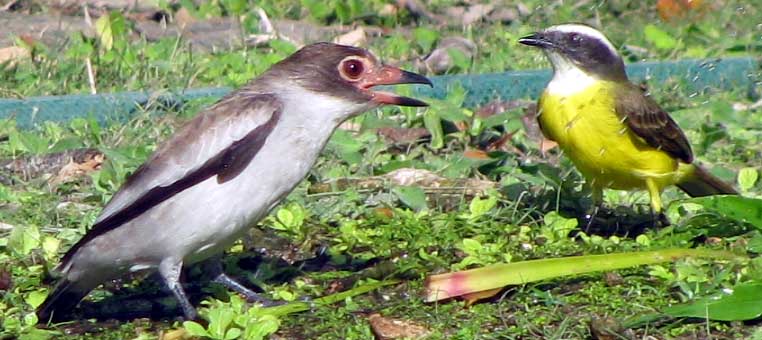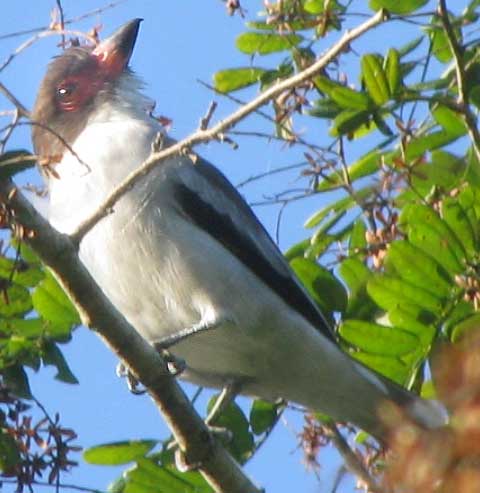Excerpts from Jim Conrad's
Naturalist Newsletter

from the March 14, 2010 Newsletter issued from Hacienda Chichen Resort beside Chichén Itzá Ruins, central Yucatán, MÉXICO; limestone bedrock, elevation ~39m (~128ft), ~N20.676°, ~W88.569°
TITYRA MEETS FLYCATCHERS
The dry season's harshness also probably was behind what I saw early Friday morning: A Masked Tityra and a Social Flycatcher on the ground together. A watering hose had sprung a leak and the birds were enjoying a shower, though the tityra didn't seem too pleased to share his space with the flycatcher, as seen above.
By the way, there's nothing wrong with the tityra's face. The bare, pinkish eyering and pinkish beak base remind us of how mange looks on a dog, but this is the tityra's natural appearance, an important fieldmark.
from the November 29, 2009 Newsletter issued from Hacienda Chichen Resort beside Chichén Itzá Ruins, central Yucatán, MÉXICO; limestone bedrock, elevation ~39m (~128ft), ~N20.676°, ~W88.569°
MASKED TITYRAS
One of the most distinct birdcalls you hear here is that of the Masked Tityra, TITYRA SEMIFASCIATA. In A Guide to The Birds of Mexico and Northern Central America, Howell, whose writing is usually rather dry, describes the sounds made as "distinctive buzzy or fart-like calls, zzzu rrk or zzr zzzrt, and rr-rr-rrk, etc." That's right, if you stipulate that they're the quick, dry kind of fart. I've always thought of the calls as like those Donald Duck used to make when he was too angry for words. You can see one giving me the eye below:

Unfortunately that picture doesn't show well one of this bird's main features -- the broad eyerings and lores (area between eyes and bill) of bare, pink skin causing the bird to look as if its wearing pink goggles. The males' bold black-and-white plumage and short, hooked bill cause this to be one of the easiest-to-identify birds found here. Tityras belong to the same family as the becards we looked at last week, the Cotinga Family, a Neotropical family not yet figured out taxonomically, but surely close to flycatchers.
Masked Tityras are common and widespread, distributed throughout Mexico's humid lowlands south all the way to Brazil. They specialize in semiopen places with scattered trees, such as plantations and recently abandoned fields, so this is one species that may have benefited from human activity.